Flatiron's Guide to Austrian Wine, Part 3: Niederösterreich is Never a Bad Idea
NIEDERÖSTERREICH / lower austria
(nee-der-o-stir-ike)
Lower Austria is most famous for the Wachau, by far its best known region which we discussed in detail in Part 2 of this guide. But the true beauty of Lower Austria is found in its diversity.
There are thousands of small family farms. Some are still polycultural--where vines are just a portion of their overall food crops. Others are for weekend farmers with jobs in town or Vienna. And the countryside is dotted with Heurigern, the small-scale seasonal taverns that are only allowed to sell food and wine produced on site. The word, Heuriger, means “this year’s wine”: no imported Grand Crus here!
And then there’s the legion of estates with more ambition and the goal of world-class winemaking. We are fortunate enough to be able to get lovely examples of these producers in America, and each of our guides will help you to understand who these producers are, where they work and what their raw materials are like.
The landscape of Lower Austria is shaped by the Eastern Alpine foothills flattening out to meet the soaring Bohemian Massif and the start of the Western Carpathians.
The terroirs are as diverse as the producers: ancient limestone sea beds, eroded volcanoes, alluvial river beds, and massive pillows of glacial loess sand and dust. This plethora of soil compositions, aspects and elevations make for an endless stream of phenomenal, distinctive wines.
Lower Austria is the largest and most diverse of Austria's four classic regions. The Wachau though famous, is only a (tiny) one of its eight subregions, which also include: Kremstal, Kamptal, Wagram, Traisental, Weinviertel, Carnuntum, and Thermenregion.
The Wachau has the highest concentration of super-star winemakers, but the rest of the country has plenty of top notch gems scattered about. Names like Hirsch, Bründlmayer and Bernhard Ott have been sought out by collectors for decades. Up-and-comers Jurtschitsch, Hager and Dorli Muhr, are quickly gaining popularity for their expressive, terroir-driven wines.
Respekt (respect) for the land is paramount. All six of those producers, along with hundreds more, use organic or biodynamic principles in their farming. Many others work sustainably. The small scale of Lower Austria’s tiny farms helps keep this a vibrant place to grow grapes and food with traditional hands-on methods.
Although every grape variety grown in Austria can be found in Lower Austria, Grüner Veltliner is far and away the reigning champ. Zweigelt comes in second place in terms of overall planting, but gorgeous wines from Riesling, Roter Veltliner, and even Pinot Noir are worth seeking out.
With such diversity it can be hard to summarize the region’s wine style. But to us, the heart of the matter is that Lower Austria gives us authentic wines, whether they are age-worthy bottles that radiate intensity or simple but tasty wines that you can easily imagine drinking at some roadside Heurigen in the fall sunlight with friends. And best of all, they do this at incredibly fair prices.
Wine Labels of Lower Austria
DAC (Districtus Austriae Controllatus)
With all this great terroir, it makes sense that Austrian winemakers would want to use the names of their regions of origin on their labels to help tell customers something about what’s inside the bottle -- as well as to convince them of its quality. And just as France protects regional names (like Champagne, Margaux, or Le Chambertin) with its AOC system of rules (the Appellation d’Origine Controlee), so Austria protects its regions with a DAC system.
If a winemaker wants to use a protected geographic name on a wine, they must follow a whole host of rules meant to ensure that the wine will live up to its reputation and not disappoint the drinker. The overarching requirement is that the wine must express the origin and typical style of its place of origin -- in other words, the primary character of a region.
In practice, this means regions decide not only which grapes are most typical of that region (and are therefore permitted in labelled wines), but in what style the wines must be made. If there’s no tradition of Rosé Pet Nat in the Kremstal, no grower is going to be allowed to put the Kremstal label on their Rosé Pet Nat.
But it gets even more granular than that. Growers have to submit their wines to a regional DAC tasting panel for evaluation. The panel picks a benchmark wine for that year (one which hits all the correct regulated stylistic notes given the vintage), and wines that are too dissimilar are barred from using the DAC label.
If your wine doesn’t taste that way to the panel (or it isn’t made with the prescribed grape variety), you can only label it with the generic Niederosterreich.
Each region sets its own rules which vary slightly. Some regions have chosen more than one grape variety to represent their region, like Grüner Veltliner and Riesling.
Most subregions have a Klassik (the basic DAC) level: lighter, fresher, easier drinking, lower alcohol, unoaked, with no botrytis. Such wines can be submitted for tasting as early as January following the harvest.
Some include a Reserve category, where wines are fuller bodied and higher in alcohol. They can show some oak or botrytis influence, and are meant to be more concentrated and age-worthy. They can’t be submitted for tasting until the March following the harvest.
Austria’s Quality Pyramid: Three Tiers of Terrific
Burgundy is famous for having multiple tiers of wine, from the “lowly” Bourgogne Rouge (which can come from anywhere in Burgundy), up through the Village Wine (like Puligny Montrachet, which can come from anywhere in that village), all the way to the wines that can only come from a single vineyard (like Meursault Perreriers Premier Cru, or Le Montrachet Grand Cru, each of which can only come from that very vineyard.
Likewise, Austria has created three tiers for their wines, a system which maps on to the Burgundian system pretty directly.
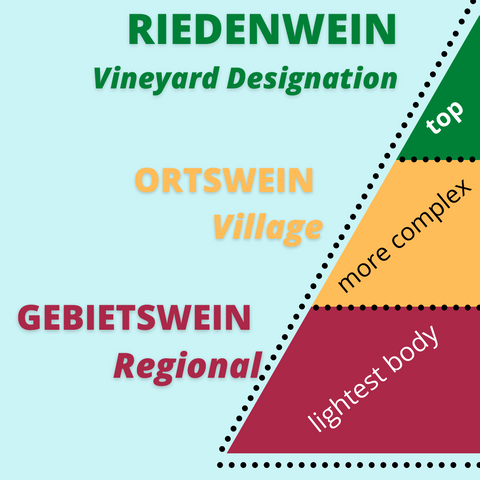
- Gebietswein “Regional”
Gabietswein, the largest designation, can come from anywhere in a named region. So a wine labelled simply “Traisental DAC” could be from any vineyard in any village in the Traisental DAC. Gebietswein is also the most basic and lightest body. This is somewhat similar to a simple Bourgogne.
- Ortswein “Village”
Ortswein can be labelled with the name of a single village, but must be from a much smaller area, typically from vineyards around a specific village. The wines are also more complex, slightly fuller in body. These are similar to a village level Burgundy.
- Riedenwein “Single Vineyard Wines”
These choice wines come from the very smallest areas of all: a single vineyard. Riedenwein is the top tier, most complex and fullest bodied, and can have a Ried (site) name added to the label - similar to a 1er Cru or Grand Cru Burgundy.
Basic DAC guidelines for each region will be touched on below.
Österreichische Traditionsweingüter / ÖTW
(Austrian Traditional Wineries)
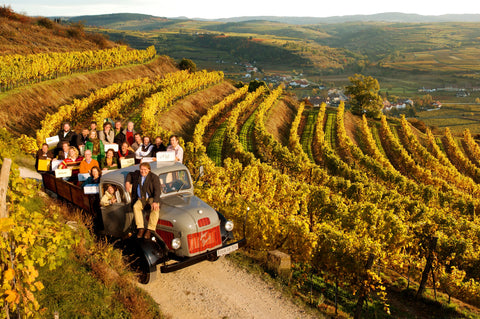 © Traditionsweingüter Österreich
© Traditionsweingüter Österreich
Lower Austria’s answer to the Vinea Wachau of Wachau and Germany’s VDP.
The government created the DAC system to give drinkers certainty about the style of a wine to be expected from a certain place. But years before that system was put into place, the ÖTW formed to look at distinctions between individual vineyards, rather than generic regions.
It started as a group of seven winemakers who came together in 1992 with the express goal of identifying and ranking the great vineyards of Austria.
Today the ÖTW is up to 32 member estates and has classified 81 vineyards across Kremstal, Kamptal, Wagram, Traisental, Carnuntum and Vienna as being Erste Lage or 1st Growth (sites which show distinguished terroir in the wines grown there).
Once the terroir of a delineated site has been acknowledged and approved, wines from that vineyard can be stamped with the ÖTW symbol. This symbol gives consumers an easy way to to identify a wine as coming from a top site. By providing us with this sort of insight, they hope to give us an easy way to begin to understand and appreciate the myriad places these wines come from as much as they do.
ÖTW members see their classifications as an extension of the DAC system. Wines further subdivided from regional distinctions into single vineyards for greater specificity. Only wines which follow all DAC rules, and come from a designated single vineyard and taste like that vineyard can carry the “ÖTW” logo.
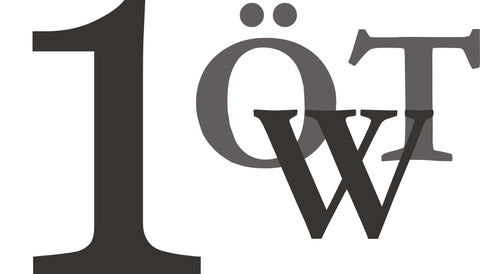
Not every wine with the logo is going to be to your liking but they are an indication of quality and a fun way to become intimate with the vast and varied terroir of Lower Austria.
The Sub Regions of Lower Austria
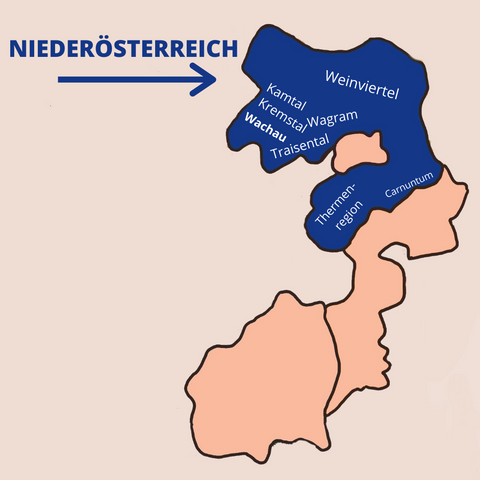
Climate Tug of War
All of Lower Austria is beholden to the same combination of opposing weather patterns. Cold air comes down from the north and west and is buffeted by hot gusts from the east across the Pannonian plain in Hungary.
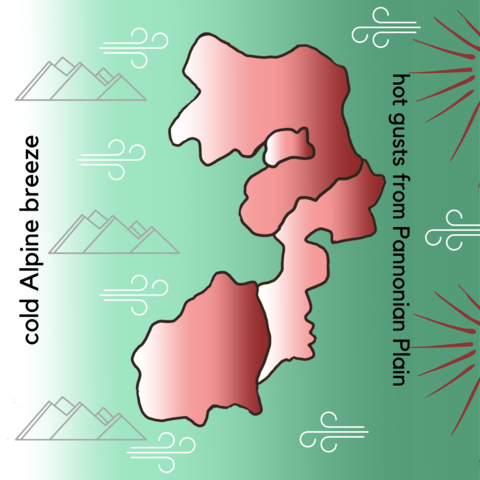
How hot or cold a particular sub region or even vineyard is, is determined by how protected it is from one or both of those major climatic features. Mountains, hills, forests, elevation, aspect, river, soil color and type and even towns can also affect the temperature, the grapes planted, and the overall styles of wines made in each place.
Wachau
As we mentioned at the top of this blog, the Wachau Valley is easily the most famous and recognized region in Austria. The wines have been lauded by critics, cherished by collectors, and enjoyed by wine lovers for decades. It’s so important to understand the wines of Austria, we gave it it’s very own post. Read all about its long history, unique terroir, superstar producers and best vintages in our Guide to the Wachau.
Kremstal
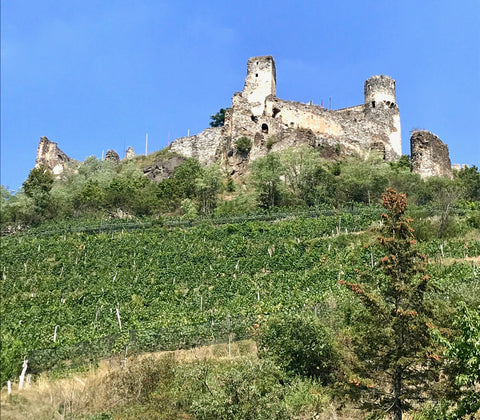
Named after the town of Krems, an ancient winemaking town on the northern bank of the Danube. The Kremstal region is about twice the size of its western neighbor, Wachau. Soils and microclimate divide it into distinct sections, with different styles of wine produced in each.
The western edge, called Stein, was part of the Wachau before the Wachau’s producers tightened control of their region in 1985 and drew up new boundaries. Here, vineyards are largely indistinguishable from the Wachau’s steep, stony terraced vineyards gneiss and primary rock. Some of the best mineral driven Riesling is grown here.
North of the town of Krems runs the Krems river, a tributary of the Danube, down a valley from the village of Senftenberg. This is the coolest part of the region and the vineyards are mostly steep and terraced primary rock. This is where to find both aromatic and structured Grüner Veltliner and Riesling.
Back down the valley, running east toward Kamptal and Wagram are the thick layers of water retaining loess, perfect for thirsty Grüner. Days are hot and open to the warm gusts from across the Pannonian plain and vineyards are somewhat protected from the cold northern winds. Wines tend to be opulent and spicy.
From there the steep valley opens up south across the river to the thousand-year-old Göttweig Abbey. The Abbey still has vast vineyard holdings, but many are leased out to other growers. The soils are gravel and sand from the river bank, and the wines are generally soft, easy drinking. Some single vineyard wines on the gently sloping, primary rock vineyards can have good minerality and are excellent values.
Kremstal DAC
- Starting in the 2007 vintage
- Grapes: Grüner Veltliner & Riesling
- Quality Pyramid - Gebietswein, Ortswein, Riedenwein
- Kremstal DAC style (for all three levels) - Dry, wines get fuller in body as they go up the pyramid. Spicy and fresh Grüner Veltiner, aromatic and mineral Riesling. No overwhelming influence of Botrytis, well balanced, concentration commensurate with that typical of the specific vintage year.
- Kremstal DAC Reserve style - robust, ripe aromas, density on the palate and often a long and smooth finish. Pronounced regional character, concentrated and long in the finish; delicate tones of Botrytis or wood are permissible.
ÖTW in Kremstal
Kremstal has the highest number of Erste Lage vineyards spread over diverse terrain. Our favorites are listed by vineyard name and village.
- Gebling, Krems
A terraced ridge with good southwest exposure, very complex soils, calcareous with loess and gravel. First documented in 1284!
- Hochäcker, Senftenberg
Senftenberg is up the Krems valley, which is the coolest part of the region. One of the highest vineyards at 1,200 ft, terraced with mica-schist. A top notch site for peachy Riesling with loads of minerality.
- Pellingen, Senftenberg
Moderately steep, terraced vineyards of mica-schist, separated from Hochäcker by a wall. Aromatic and spicy Grüner Veltliner grows here.
- Pfaffenberg, Stein
A natural extension of the weathered primary rock, gneiss and schist, with terraced vineyards of the Wachau. Very windy with huge diurnal temperature swings. Knoll and several other Wachau producers have parcels here.
- Silberbichl, Furth
Right on the edge of the Wachau’s south bank of the Danube. Mainly mica-schist soils, great for Riesling.
Some Favorite Kremstal Producers

A beautiful Kremstal estate at the end of a cool valley, surrounded by steep loess and rocky slopes. Only in its second generation, father and son, Martin Sr. and Martin Jr. are quickly elevating their reputation around the world.
A tasting at the winery last September floored us with a kaleidoscopic array of flavors across the line up of intense and concentrated wines. The aged bottles were magical. Martin Jr's recent influence has pushed the wines towards more elegance and freshness with their Kremstal Grüner Veltliner, a perennial staff favorite.
Malat
Michael Malat is the 10th generation of his family to run this estate on the south bank of the Danube. Michael’s father claims to be the first in Austria to make a traditional method sparkling wine, something the estate still excels at.
The Malats were founding members of the ÖTW along with Willi Bründlmayer and Michael Moosebrugger from Schloss Gobelsburg. They make beautiful single vineyards but also delicious regional bottlings from Grüner Veltliner and Riesling. They farm all of their vineyards organically.
Berger
Humble but energetic wines from the jovial Erich Berger. His liter bottles of Grüner Veltliner and Zweigelt hold permanent spots on our grab-and-go tables here at Flatiron for their ability to capture the easygoing typicity of the Krematal. His Gelber Muskateller is built for a sunny day at the beach or as an antidote to the winter blues. And his single-vineyard wines just get better every year but are still incredible values.
Kamptal
One might think Kremstal, which is at the doorstep of the Wachau, might share some of its fame and reputation among Austrian wine lovers. But that recognition falls squarely on the shoulders of winemakers in the Kamptal and is well deserved.
Top wines here share many of the powerful, complex, and long-lived capabilities of the Wachau, but still capture the singular essence of the Kamptal. It’s the everyday bottles here which often capture the freshness of cold nights, the structured hot days and the striking minerality of the varied soil types, at easy to digest prices.
The landscape is idyllic, lush green fields, rolling hills, thick forests and twisting rivers are dotted with picturesque towns, villages and grand monasteries. A plain stretches out from Kremstal in the west to Wagram in the east, with the Danube river on its south edge, fed by the Kamp river, bisecting the Kamptal valley into the mountains along the northern spine of the region.
This is a hotspot for Riesling, not in terms of quantity, but definitely quality. The geologically unique Heiligentstein is unbeatable. Guner Veltliner reigns supreme both in the lower layers of loess and in some of the stonier, higher elevation sites. Zweigelt is readily planted and can be found in styles as diverse as fizzy pet-nats, quaffable daily drinkers, to alluring eiswein. This is the first region where you start to find more diversity in grapes with Roter Veltliner, St Laurent, Pinot Noir, Chardonnay and Weissburgunder all making a stand.
Kamptal is a region that has it all: a prevalence of organic growers, centuries of tradition, forward thinking modernists, interesting grapes, wide range of styles and fantastic winemakers who know how to use their unique terroir to the best of their abilities. It’s very much worth your time and investment getting to know these wines.
Kamptal DAC
- Starting with the 2008 vintage
- Grapes - Grüner Veltliner & Riesling
- Quality Pyramid - Gebietswein, Ortswein, Riedenwein
- Kamptal DAC style, of all 3 levels = Dry, fresh, with personality, pleasantly light on its feet and yet exhibiting concentrated structure, no dominant botrytis flavours, well-balanced, with the concentration typical of the vintage indicated.
- Kamptal DAC Reserve style = rich in character with appreciable depth, unmistakable expressions of their origins, pronounced regional character, extremely concentrated and long in the finish; delicate notes of botrytis or oak are acceptable.
ÖTW in Kamptal
The most renowned vineyards outside of the Wachau are located in the Kamptal. Here is a short list of our favorites to look out for by Vineyard, and Village:

- Heiligenstein, Zöbing
- Lamm, Kammern
- Grub, Kammern
- Gaisberg, Kammern, Strass, Zöbing
- Renner, Kammern
- Käfferberg, Langelois
- Loiserberg, Langelois
Soaring up to 1,400 feet, this cool site is southeast facing with schist soils, and makes a pretty Grüner Veltliner at good value.
Kamptal’s Producers
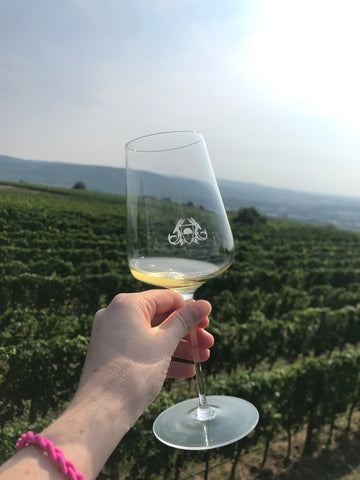
Brundlmayer is among the greatest estates in Austria and arguably among the very greatest white-wine producers in the entire world. Quality has gradually increased even further under the watchful eye of Andreas Wickhoff, MW, who took the helm from Willi Bründlmayer in 2014.
The entry level wines are the purest examples of straight-up Kamptal Riesling and Grüner you could hope for. But the fancier bottlings are truly next level, transmitting the multi-faced soil, aspect, elevation and micro climates throughout the Kamptal. The estate is always pushing the boundaries of what one could expect from their vines and with great effect.
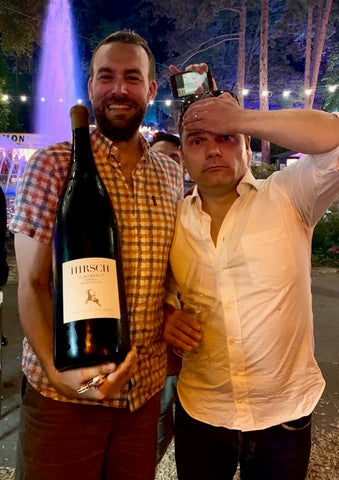
One reason that Weingut Hirsch's wines are so good is that Johannes Hirsch did a lot of things first. He was one of the first in Austria to dump Chardonnay and really focus on Kamptal's great varieties of Riesling and Grüner Veltliner. He was one of the first to farm biodynamically. He was first to switch all closures to stelvin. So he's had a longer time to perfect this style of hyper-artisanal winemaking than virtually anyone else in Austria.
There were hiccups along the way. Not everyone loved the Rieslings from the late aughts that ended up with some residual sugar. But it turns out that this was just what nature wanted to do in those vintages. And since then, Hirsch (and nature) have made nothing but classical, dry Grüners and Rieslings. He has avoided the trend towards higher octane Austrian wines that we have seen elsewhere. With lower alcohol levels, Hirsch shows the pure, crystalline essence of Austrian Grüners and Rieslings.
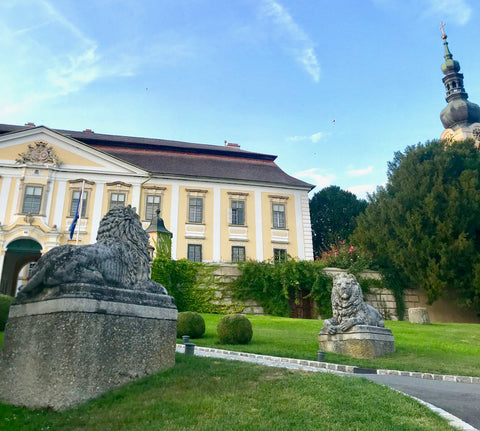
A Cistercian monastic estate founded in 1171 (!!!), Schloss Gobelsburg is one of the largest holders of local “Grand Cru” terroirs: Heiligenstein, Gaisberg, Lamm, Renner, and Grub. When you mix all that tradition and terroir with top-notch winemaking you get brilliant, age-worthy wines of complexity and depth.
Eva and Michael Moosbrugger were granted the winemaking and viticultural contract in 1996, and with the help and guidance of Michael’s mentor, Willi Bründlmayer, the winery has regained its prestige and is considered to be a leader in quality and innovation.
Not everyone in Kamptal is a celebrity winemaker, it’s home to humble growers with delicious everyday wines as well. Matthias Hager is the 5th generation to inherit his family farm, but wasn’t satisfied with the status quo. He converted his vineyards to biodynamics and slowly altered winemaking to more non-interventions methods.
He has a wealth of old vines on varied soil types and plots scattered across 14 hectares in the small town of Mollands, in the cooler Kamp river valley. The single vineyard and village level Grüner Veltliners are excellent, but crunchy pet-nats and a delectable St Laurent Eiswein are quirky but tasty.
Vanguards of the natural wine scene in the Kamptal, an Austrian region known for elegant and aromatic wines. The young couple, Alwin and Stef (a daughter of the Gunderloch family in Germany) took over his family estate, the oldest in the Kamptal in 2006. Like Hager, they’ve converted everything to organics and gone further than that, using alternatives to copper sulfates for sprays and protecting the biodiversity of the forests around them.
All of that would be for naught if they didn’t also produce some of the most elegant, traditionally-classical wines in the region. Rieslings especially are high acid, elegant and aromatic and still so fairly priced.
Traisental
Austria’s newest wine region, established in 1995, is also one of its smallest. The vineyards are mostly on the western shores of the Traisen river, a tributary, flowing north out of the Alps into the southern bank of the Danube.
Not well known outside of Austria, it does produce distinct wines from the rest of its neighbors thanks to its unique soils and weather patterns. It is buffeted by near constant, cold, north-blowing wind from the Alps (rather than south-blowing from Czech), along the river valley, combating the hot eastern Pannonian gusts. This leads to cold nights and high acidity and keeps disease pressures at bay.
Soils have far more carbonate and limestone than the rest of Niederösterreich, imparting a minerality distinct in this region. Loess is prevalent and unsurprisingly planted to Grüner Veltliner, which takes up the highest percentage of vineyards of any region in Austria. Riesling is planted in some of the stonier, higher terraces.
Both grapes produce fresh, fruity and spicy wines and the reserve bottlings are mineral laden and long-lived, although they are a rarity on our shores. Many of the other Austrian and international grapes, red and white, can be found at most estates, although in tiny quantities.
Traisental DAC
- Started with the 2006 vintage
- Grapes = Grüner Veltliner & Riesling
- Quality Pyramid = Gebietswein, Ortswein, Riedenwein
- Traisental DAC Style - All three tiers must show now overwhelming influence of botrytis, well balanced, concentration commensurate with what the vintage will allow.
- Traisental DAC Reserve Style - robust, pronounced regional character, concentrated, long on the finish, delicate tones of botrytis and wood are allowed.
ÖTW in Traisental
Erste Lage Vineyards, Villages
- Alte Setzen, Reichersdorf
- Berg, Getzerdorf
- Rothenbart, Inzerdorf
- Zwirch, Inzerdorf
Traisental’s Producers
- Neumayer
- Weingut Marcus Huber
Wagram
While Wagram is by no means a newly recognized region, the name is unfamiliar to many since the region changed its name in 2007. Formerly Donauland, Wagram is a large area which leads into the Kamptal in the west, and is a natural extension of the vineyards there. Along the northern and eastern borders, this region shares famously biting northern winds with the surrounding Weinviertel. Luckily, here the winds are tempered by a 1,000 foot slope which marks the northern edge.
From these hills the Wagram stretches south across the Daube to the Traisental and then east to the edge of Vienna. This corner is where Austria’s largest privately owned winery, the Klosterneuburg, founded in 1114, is based.
It’s a massive Baroque monastery, whose size was halted when Archduchess Maria Theresia (the only female to rule the Habsburgs) put a stop to its continuous expansion projects. The cellars alone are 3.7 miles long (!!!) and like many Austrian monasteries, own massive tracts of vineyards (108 hectares) across the country.
More importantly to today’s wine world, Klosterneuburg is home to the first viticulture and oenology school, established in 1860. Many of not only Austria’s, but the world’s greatest, winemakers have passed through it’s halls.
Wagram’s northern ridge is a massive south facing hill covered in loess, up to 90 feet deep in some places and is home to its best vineyards and winemakers. Again the loess makes it a natural hotspot for Grüner Veltliner, which dominates almost half of the land under vine. Red grapes are more prevalent here than Kremtal or Kamptal, but few bottles are imported to the US.
Some Riesling is grown, and you can find interesting Roter Veltliner, an indigenous white grape not related to Grüner, gaining a following here. It can be difficult to grow, needs years to show its best and fights Grüner for the same prime vineyard locations.
Wagram DAC
- Wagram does not have a DAC, yet.
ÖTW in Wagram
Erste Lage vineyards, Villages
- Brunnthal, Fels am Wagram
- Mordthal, Ruppersthal
- Rosenberg, Feuersbrunn.
- Scheiben, Fels am Wagram
- Schlossberg, Oberstockstall
- Spiegel, Feuersbrunn
Wagram’s Producers
Berhard Ott

Wagram doesn’t have a high concentration of spectacular producers, but it is home to one of Austria’s very best: Bernhard Ott from the village of Feuersbrunn.
Benhard pioneered organic and biodynamic winemaking in Austria after a trip to the Domaine Romanee Conti in Burgundy, where Aubert de Villaine was making the world’s greatest wines with biodynamics.
Upon his return to Austria he and fellow winemakers Johannes Hirsch and Fred Loimer established Respekt-BIODYN, a community oriented group of farmers committed to helping each other and the earth through biodynamics.
He even goes as far to make his own compost, a task most growers avoid, but which makes Bernhard giddy as a school boy when showing off his tarp covered piles.
Composting may sound like a bunch of shit to some, but his heaping use of the stuff has enabled enough water retention that he doesn’t need to irrigate, even in these record breaking hot recent vintages.
Bernhard has been in charge of his 5th generation estate since 1993 (at the age of 21), but never stopped experimenting, whether with vessels, stem and skin contact, farming techniques or different grapes. His ultimate goal has always been to prove that his single vineyards, Rosenberg and Spiegel, were capable of producing world class, long lived wines.
Grüner Veltliner soars to new heights in his capable hands and his first three tiers Am Berg, Fass 4 and Der Ott are some of the best values in Austria.
Other producers to look out for:
Weingut Leth and Ecker
Carnuntum
2,000 years ago this was the largest outpost of soldiers away from Rome and is still rife with archeological wonders. South of the Danube and Vienna, north of Burgenland with the Slovakian border on its east, it gets the full blast of the Pannonian warm air currents, making it our first stop in red wine country.
50 years ago Gemischter Satz, which are field blends of mostly white grapes, dominated plantings. Today Grüner Veltliner, Chardonnay and Pinot Blanc are grown in ⅓ of vineyards but with climate change the balance has quickly turned to ⅔’s red, mainly Zweigelt but St Laurent, Blaufränkisch, Pinot Noir, Cabernet Sauvignon, Merlot and Syrah are all to be found.
Three eroded mountains, now barely hills, stretch east to west. Höflein and Göttlesbrunn are villages with loam, loess and sandy gravel on gently sloping hillsides. Mechanical harvesting is often employed and many growers have invested in costly optical sorters, machines that can sense when a berry is ripe or not. These investments have allowed larger than average operations to become established. But top growers like Markowitsch making quality handmade wines here.
The village of Prellenkirchen in the far east is a new bastion of quality. Until 1990 most of the grapes were sold off the local co-op until it closed. At the turn of the century a few like minded growers started revitalizing the limestone sloped vineyards, and set their sites on quality, handmade wines.
Carnuntum DAC
- Starting with the 2019 vintage
- Grapes
- White: Chardonnay, Weissburgunder, Grüner Veltliner
- Red: Zweigelt & Blaufränkisch
- The region allows blends, as long as any of those 5 grapes makeup at least ⅔’s of the blend.
- Quality Pyramid - Gebietswein, Ortswein, Riedenwein
- Style, Red - Dry, elegant, robust character in a lively and refreshing way.
- Style, White - Dry, opulent fruit with firm structure.
ÖTW in Carnuntum
For generations Carnuntum was known for regional blends and bulk wines. A new generation is working to identify and vinify rediscovered single vineyards. Our favorites are listed by vineyard and village.- Schüttenberg, Göttlesbrunn
- Spitzerberg, Prellenkirchen
The “Pointy Mountain” is located in the far eastern corner, just across the border from Bratislava are the primordial remains of a sea shore. It is home to delicate Blaufränkisch, compared to its Burgenland neighbors the slightly cooler, higher elevated limestone vineyards impart a lift and minerality to the spicy high acid wine.
Carnuntum’s Producers
Markowitz
Markowitz is a traditional grower in the village Göttlesbrunn. His rolling vineyards are on loam, loess, sand and even some limestone and all of his vineyards are farmed without irrigation, difficult in this dry climate. He makes a series of blends both of grapes and different sites, typical for the region but his Pinot Noir and single vineyard wines are intense and age beautifully.
Weingut Dorli Muhr
Located in Prellenkirchen, this tiny estate on the Spiterberg was started by Dorli and her now ex-husband Dirk Niepoort, famed vitner from Portugal. Dorli, a wine lover, grew up in a nearby village and knew the potential of this site. She and Dirk bought and then inherited vineyards which they have converted to organic viticulture.
Winemaking is experimental with different amounts of skin contact, stem inclusion and vessels employed. Nothing but SO2 at bottling is added and even so the wines are all elegant, clean and expressive.
Weinviertel
The largest region in Austria is a little too big to have any sort of homogenous definition. It finds unity under its massive plantings of Grüner Veltliner with more than ½ the world’s vines found here and the first DAC only applied to Grüner and its spicy, aromatic iterations.
Austrians know this is the go-to zone for the best of the inexpensive, crisp, spicy white wines they adore. A side effect is a tendency to look down on or avoid those producers focusing on more concentrated, long-lived, and more expensive wines. Those winemakers intent on distinguishing themselves often have to look outside their own country to find a market.
The wide plain and rolling hills of Weinviertel stretch between Czech to the north, Slovakia to the east while Kamptal, Wagram, Vienna and Carnuntum splay out along its south-western border. The lack of steep sites mean machine harvesters are prevalent, keeping costs down but also diminishing quality.
You can find granite outcroppings in the west, limestone cliffs on the northern borders, but everything from loess, sandstone, quartz, clay, gravel or sand offer a huge variance of mineral underpinnings to the wines.
Climatically, the northwest is cooler and well suited to Grüner Veltliner and Riesling with warm days but cold nights. As you head south and east towards the pannonian plain the temperatures get warmer and some of the most opulent red wines of Lower Austria are found here, along with sweet wines.
Rainfall is low and drought can be a problem, especially in the west, one of Austria’s driest zones. But along with the constant flowing cool breezes, it also means optimal conditions for organic viticulture. Not many producers are certified due to cost, but many opt for non-chemical interventions.
While Grüner does take up ½ the vineyard area, the other half of the vineyards are divided among a cacophony of different varieties: Riesling, Welschriesling, Weissburgunder (Pinot Blanc), Chardonnay, Roter Veltliner, Traminer, Zweigelt, Pinot Noir, Blauer Portugieser and St Laurent.
Weinviertel DAC
Austria’s first, awarded DAC in 2002- Grape = Grüner Veltliner
- Weinviertel DAC style = lighter in body, can have up to 6 grams/liter of residual sugar (to temper acidity), aromatic, spicy, pepper notes, no botrytis, no oak notes
- Weinviertel DAC Reserve style = Fuller bodied, dry (no residual sugar), spicy subtle botrytis notes and oak aging allowed.
Weinviertel’s Vineyards
Weinviertel is not part of the ÖTW organization. But their top villages are:
- Retz - North west, near the border, historic wine-trading town and has a labyrinth of underground cellars. Very dry climate favouring red wines.
- Röschitz - A granite outcropping in the north west where Riesling and Grüner Veltiner can find elegance.
- Poysdorf - northeastern corner on the Czech border and very cold. Home to very spicy Grüner Veltliner as well as Welschriesling and Burgundian varieties.
- Saatz & Falkenstein - Limestone cliffs to the north east of Poysdorf give an intriguing minerality to the white and red wines.
- Mannersdorf an der March - Along the edge of a river along the south eastern border is warmer and where you can find fuller bodied reds and whites along with sweet wines.
- Wolkersdorf - To the south, and just outside of Vienna is where steeper slopes of calcareous sandstone and marl makes beautiful Riesling.
Weinviertel’s Producers
In a region so diverse there isn’t a defining style or group of producers. The best growers do so with excellent farming, matching varietal to the many varied soil types, and careful cellar work.
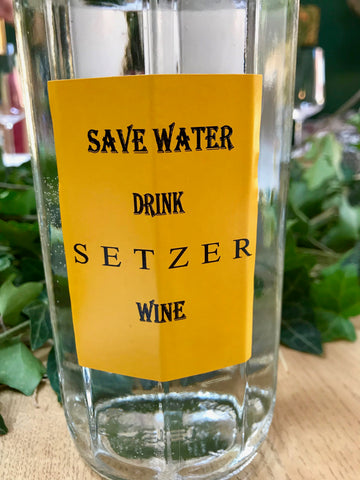
Established in 1730 in the tiny village of Hohenwarth on the border of Kamptal and Wagram. Hans and his wife Ulli are doing everything they can to take advantage of their unique sub region of calcareous loess over gravel, sandstone and limestone at a soaring 1,200 feet (higher than Wagram).
Vines are not irrigated or sprayed with chemicals and density of more than twice the average of the region. Several single vineyard wines showcase the unique soils but their midtier bottling of Grüner Veltliner on mostly limestone really shines and their Roter Veltliner is a great example of this dense grape.
Michael Gindl
This polycultural family farm, historically the norm in Austria, was taken over by Michael after high school in the early 2000’s. The soils are loam, loess and sandstone and all the vineyards have all been converted to biodynamics.
Wines are made as gently and hands off as possible and mostly in acacia and oak he harvests from his own forests. Everything from Grüner Veltliner to Cabernet Sauvignon to Samling 88, one of the disease resistance varieties developed at Klosterneuburg are grown here. His wines are as energetic as their winemaker.
Sektkellerei Christian Madl
This tiny estate on the Czech border in Poysdorf makes not only some of the best sparkling wines in Austria, but anywhere outside of Champagne. Everything at this address is treated like Champagne – grapes are hand harvested, pressing is gentle and Christian uses only the cuvée for producing his wines.
Christian uses Welschriesling, Riesling, Chardonnay, Pinot Blanc, Pinot Noir, Grüner Veltliner and Zweigelt for his wines. Wines are fermented in stainless steel and wood, depending on the cepage, vineyard and wine he is producing.
Bottling is normally done in spring when the liqueur de tirage is added. All of Christian’s wines are on the lees for a minimum of 15 months and up to 60 months. Every bottle is hand riddled prior to disgorgement. Dosage is always done by trial and tasting and is never formulaic.
Thermenregion
Named for the thermal hot springs in the town Baden, Thermenregion has a dichotomous personality, which makes sense as its two regions in one. In 1985, after the wine scandal Gumpoldskirchen and Bad Vöslau were joined, a move which obscured the personality of both and has made it difficult for the region to easily define itself.
Just south of Vienna, Gumpoldskirchen produces excellent sweet wines from sloped limestone vineyards. For centuries Gumpoldskirchener wines were just as famous as those from Rust in Burgenland; only the indigenous grapes Rotgipfler and Zierfandler had higher acidity and more aromatics.
Bad Vöslau on the other hand is farther south, flatter and full of well-draining gravelly soils. In the middle ages Cistercian monks revived the ancient viticultural practices present since before the Romans bringing Burgundian varieties with them and erecting palatial monasteries.
Constant sunshine and cold air circulation from the most eastern edge of the Alps means both red and white grapes are grown here. The wines are good but are rarely exported.
No DAC & ÖTW in Thermenregion
- There is no DAC wine for Thermenregion nor are they part of the ÖTW.
Thermenregion’s Villages
- Gumpoldskirchen, Bad Vöslau, Tattendorf
Producers to look out for
Johanneshof Reinisch
A 4th generation wine estate currently run by 3 brothers who encapsulate a perfect snapshot of the region. Their vineyards are in both the Tattendorf and Gumpoldskirchen. They are most known for their red wines of Pinot Noir and St. Laurent, but also farm parcels of Rotgipfler and Zierfandler.
Their cellar is new, but built in a traditional style with old bricks and the equipment is state of art, alongside old neutral barrels. The wines are made traditionally, allowing the wines to show terroir rather than artifice in sweet and dry styles, as blends and single vineyards.
Stift Klosterneuburg
The wine label for the Klosterneuburg winery in Wagram which has extensive holdings, especially of old vine St Laurent located here.
Stadlmann
They make traditional wines from organic vines in the Gumpoldskirchen region and have been since 1780.
Vintages
Vintage quality can vary slightly from sub region to sub region, but overall are ranked the same. Some winemakers, depending on style might make wines you prefer more in a hot year and others are preferable in cold years. Here’s a handy quick guide to vintages:
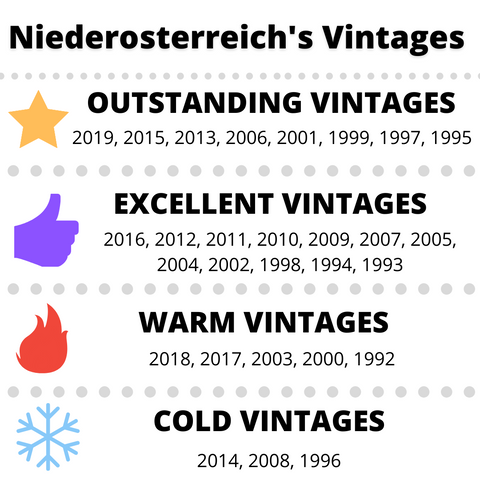
Buy Wines of Niederösterreich in NY.
Flatiron's Guide to Austrian Wine
Part 1: Tiny Country, Mighty Wines!
Austria is a beautiful country, ancient, yet modern and accessible with wines to match. The people are welcoming and generous, jovial, and wine is an integral part of their lives. The key to Austrian wine is quality and consistency, rather than quantity. No other country can boast such high standards across the price spectrum and throughout all of their regions.
Part 2: Willkommen to the Wachau!
The Wachau Valley is the epicenter of Austria’s greatest wines. In fact, to many wine consumers, the wines of the Wachau are the wines of Austria.
While that sentiment sells Austria short, ignoring many diverse and excellent wine regions, it’s not baseless. The Wachau’s vineyards, defined 1,000 years ago by local monks, are still recognized today for producing some of the world’s greatest white wines.
Read More:
A Simple Guide to German Riesling
Is Riesling always sweet? Can you pair Riesling with food? Where does the best German Riesling come from? And who makes it? All your burning questions about German Riesling, answered.
What is the deal with Sauvignon Blanc? Where is it grown? Does it taste the same from everywhere? We're answering all your Sauv Blanc Q's.
Complete Guide to the Northern Rhone Wine Region
Everything from history to terroir, what to buy and when to drink it--This is your first and last guide to a wine-geek favorite. Welcome to our Northern Rhone A-Z.
Guide to Madeira: Bottled History
Madeira is a wine of history, made by mistake and crafted by circumstance. With the ability to last for hundreds of years, sometimes it is, quite literally, bottled history. It’s a region whose great fortune was mirrored in its near extinction. The story is all here.
Ultimate Guide to the Terroir of Sancerre, Part One
Over the last several decades, the name Sancerre has become one of wine's greatest hits, a wine region with nearly unparalleled brand recognition and customer devotion. But how much do you really know about the region? Let's dive in!

